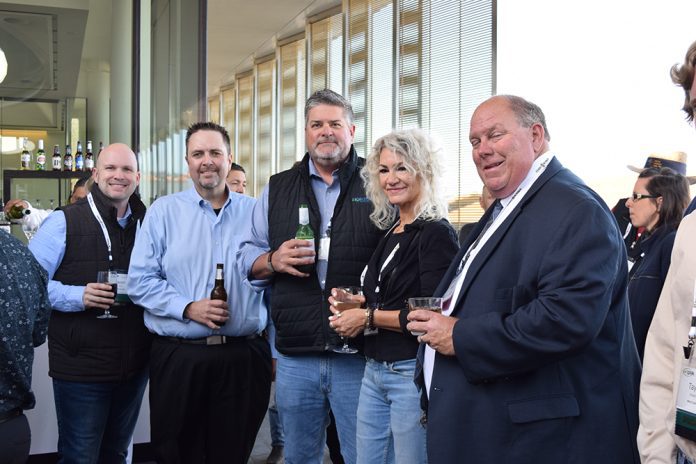
Western Agricultural Processors Association’s Annual Meeting in Monterey was an engaging industry event that brought together more than 230 attendees in Monterey on June 15 to 17.
WAPA’s Annual Meeting was a showcase of the organization’s collaborative efforts with leaders and organizations to strategically create solutions for the industry at-large.
“We couldn’t be more pleased with the incredible turnout from the members, industry partners and prospective members who attended the WAPA Annual Meeting. This event wasn’t just about WAPA as an organization, it’s about working together for the long-term health of the tree nut industry,” said Roger Isom, WAPA president and CEO.
Chairwoman Kim Keyawa-Musselman of Keyawa Orchards shared her insights from the past year of serving a two-year term.
“In serving as Chair of the Association, I’ve seen firsthand the valuable and intricate work that WAPA delivers on behalf of all its members which is critical to the industry’s vitality. WAPA fulfills such an important role as a knowledgeable spokesperson and advocate, from state legislation to local county ordinances,” said Keyawa-Musselman during the conference.
Keyawa-Musselman leads a 15-member board of directors.
More than 40-exhibitors, with one company that traveled from Australia, participated in the two-day showcase that was created through a partnership between West Coast Nut magazine and WAPA.
The unique partnership between West Coast Nut magazine and WAPA started more than a decade ago.
“We have aligned our interests to ensure the most relevant and accurate information was front and center for the tree nut industry,” said Jason Scott, publisher of West Coast Nut magazine.
Scott’s efforts have elevated the value and importance of trade media by providing critical industry news, said Isom.

Global Economy
U.S. produced approximately 4.5 billion pounds of tree nuts in 2021, led by California almonds, pistachios and walnuts. Nearly half, estimated at 1.9 billion pounds, were exported, according to USDA’s Fruit and Tree Nut Outlook (September 2021).
Dr. Victor Davis Hanson, renowned author, historian and professor, was the keynote speaker who provided attendees with an overview of world events that impacted the ability to do business in California.
He designated stagflation as the diagnosis for the nation’s halted economic growth, which would likely extend the rest of the year.
“Expect the economy to slow down, interest to increase and inflation to spike,” said Hanson.
Hanson summarized the impact of outsourcing manual and hand labor work to other countries over the past two decades. Globalization has caused the emergence of a new elite in terms of wealth, he added.
Hanson spoke of tremendous changes expected later this year in California.
He said to expect demand for a workforce with vocational skills, such as a plumber or electricians, to skyrocket.

Shipping Concerns
Exporting across the world has been one of the most important issues for the industry the past two years.
“All exporters from the U.S., whether it’s a small walnut shipper to a large manufacturer, they are all suffering without the ability to move product,” said Executive Director for the Agriculture Transportation Coalition Peter Friedman of the port congestion problem in California.
Friedman spoke during the Friday-morning session of the initiatives to alleviate port congestion.
A solution that was going to take time and patience.
Given the jurisdictions and a mixture of both government-run and privately held operations all part of port operations, the goal was to make progress over the long-term, he said.
One example that Friedman shared was expansion of port operating hours. Currently, these average five and half hours per day at five and half days per week.
Another change was to reduce loads arriving at the port by shifting to inland loading locations which move into the port via rail.
Friedman shared that inland loading started to take place with tree nuts and dairy products in California this year. He explained that inland loading has been a common practice in the Midwest and East Coast but wasn’t an option used for West Coast shipments before.
All California ports are owned by the local city government while ocean carriers (internationally owned) pay rent to the city-owned ports.
Friedman, along with WAPA, have been educating port authorities about the importance of U.S. agricultural goods.
“It’s turning port authorities into advocates for U.S. ag [goods] when historically they have been a voice for the [ocean] carriers,” Friedman explained.
California exporters have experienced a substantial increase in fees under the guise of demur and detention charges.
Friedman explained the carriers have been charging up to hundreds of dollars per day to exporters for not picking up or dropping off loads, which has been outside of exporters’ control due to the congestion issues.
WAPA co-authored a transportation committee bill (AB 2046) which passed the Assembly with a unanimous vote recently, Isom said during the event.
This effort would provide direct relief to exporters. The legislation would expand existing law on the charges an intermodal marine provider could charge for cargo that wasn’t shipped timely.
The hope was that increased accountability and transparency among ocean carriers would lead greater equity among all parties, Friedman said about the world’s nine ocean carriers which operate under three alliances.

Local, State and National Issues
Louie Brown, partner at Kahn, Soares and Conway, LP, brought a state-level legislative perspective to attendees during the business meeting.
He explained that California satisfied its constitutional budget deadline of June 15, but there was still work to do. What lawmakers approved was essentially a blueprint to the deadline, but there are still policy disagreements between the legislature and Governor Newsom, most notably how to help alleviate the impacts of inflation on people’s wallets, Brown said.
In addition, the legislature has adopted a more aggressive approach than usual on pesticide usage, he added.
WAPA staff members reviewed key industry updates.
Chris McGlothlin, WAPA’s director of technical services, provided an overview of the timeline to replace 12,000 tractors by 2024.
The association has been involved since the rule’s inception and has actively engaged local and state regulatory bodies to illustrate the need for funding to offset the cost of conversion, not only tractors but other farm-related equipment, McGlothlin said.
Funding was available throughout the state to assist in the cost of replacing engines, but it’s important for members to work with WAPA staff as multiple variables determine the level of cost-sharing and type of equipment eligible.
WAPA led a multi-year effort to establish a nut processing program at California State University, Fresno.
The college program was an investment to prepare the next generation of leaders. It started in the Spring 2022 semester, and a ribbon cutting ceremony was held April 1, McGlothlin said.
McGlothlin worked with WAPA associate members to seek donations of processing equipment. Members, including TOMRA, Forsberg, Inc., QCIFY and Chandler Automation, graciously donated to and installed equipment at Fresno State.
Isom added that this program “makes a difference in someone’s life. The membership’s generosity has started putting individuals to work in the industry.”
California’s push to reduce food and yard waste was another issue that surfaced recently. SB 1383 implementation included the effort to reduce organic waste by keeping food and yard waste out of landfills.
Isom explained that the 75% reduction in waste has regulators looking for every opportunity to make reductions in greenhouse gases.
Tree nut byproducts are an area that state and county interests have turned to sought “compliance.” WAPA intervened in opposition of tree nut facilities having to register and comply with the mandate given the extremely high usage rate of nut shells and hulls, Isom said.
Isom emphasized the organization’s success depends on involvement and support from the industry.
“Our processor members not only show up, but they offer ideas and perspectives that illuminate potential solutions to the ongoing difficulties that each operation faces,” said Priscilla Rodriguez, assistant vice president at WAPA. “It was so rewarding to work with dedicated members as this was a group effort.”
The Food Safety Modernization Act (FSMA) continued to be a key issue. Rodriguez has been engaged in the recent proposal that determines requirements for water use in agricultural settings. The association is devoted to advocacy to ensure requirements are feasible and relevant to members’ operations.















